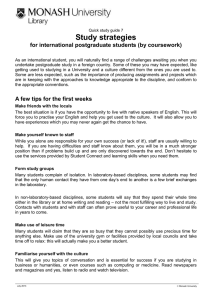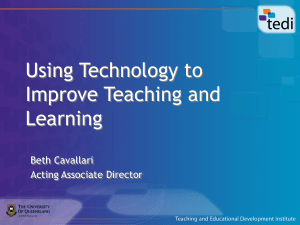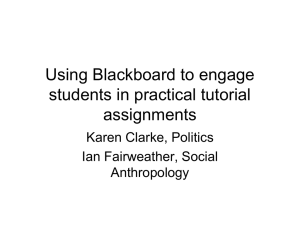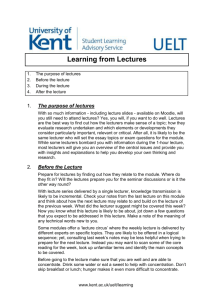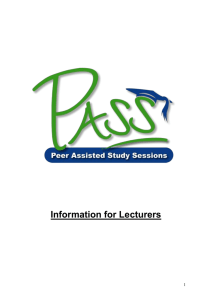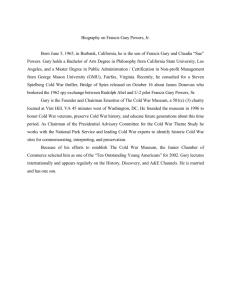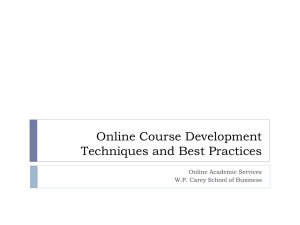GaryLynch-Wood-JacksonMaogoto
advertisement
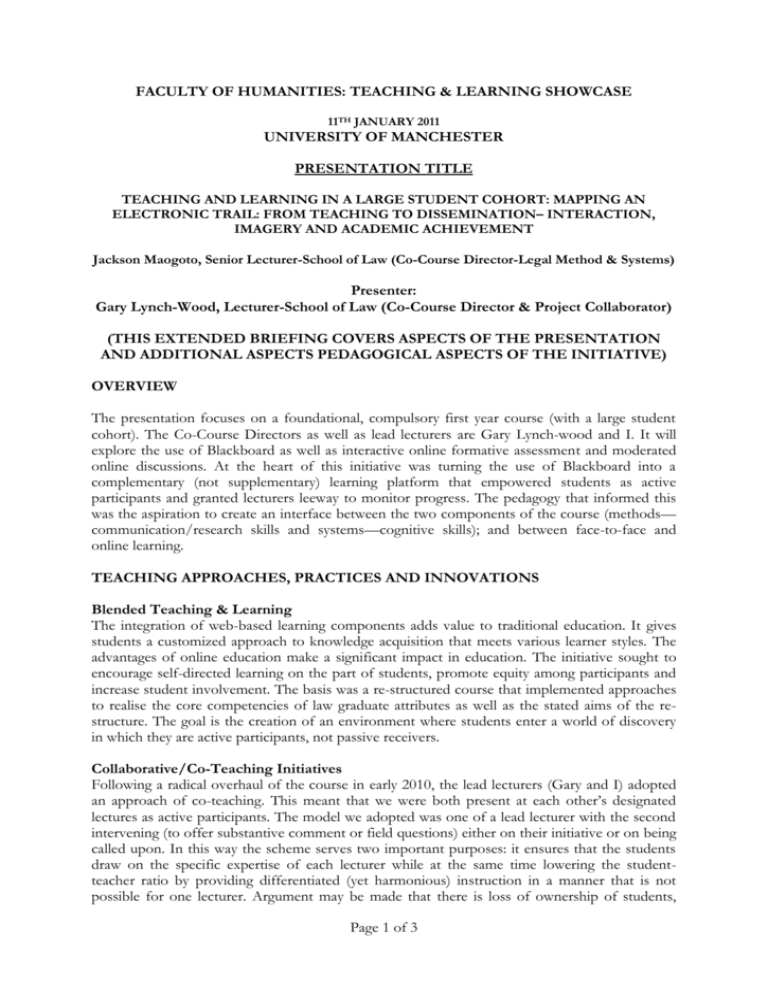
FACULTY OF HUMANITIES: TEACHING & LEARNING SHOWCASE 11TH JANUARY 2011 UNIVERSITY OF MANCHESTER PRESENTATION TITLE TEACHING AND LEARNING IN A LARGE STUDENT COHORT: MAPPING AN ELECTRONIC TRAIL: FROM TEACHING TO DISSEMINATION– INTERACTION, IMAGERY AND ACADEMIC ACHIEVEMENT Jackson Maogoto, Senior Lecturer-School of Law (Co-Course Director-Legal Method & Systems) Presenter: Gary Lynch-Wood, Lecturer-School of Law (Co-Course Director & Project Collaborator) (THIS EXTENDED BRIEFING COVERS ASPECTS OF THE PRESENTATION AND ADDITIONAL ASPECTS PEDAGOGICAL ASPECTS OF THE INITIATIVE) OVERVIEW The presentation focuses on a foundational, compulsory first year course (with a large student cohort). The Co-Course Directors as well as lead lecturers are Gary Lynch-wood and I. It will explore the use of Blackboard as well as interactive online formative assessment and moderated online discussions. At the heart of this initiative was turning the use of Blackboard into a complementary (not supplementary) learning platform that empowered students as active participants and granted lecturers leeway to monitor progress. The pedagogy that informed this was the aspiration to create an interface between the two components of the course (methods— communication/research skills and systems—cognitive skills); and between face-to-face and online learning. TEACHING APPROACHES, PRACTICES AND INNOVATIONS Blended Teaching & Learning The integration of web-based learning components adds value to traditional education. It gives students a customized approach to knowledge acquisition that meets various learner styles. The advantages of online education make a significant impact in education. The initiative sought to encourage self-directed learning on the part of students, promote equity among participants and increase student involvement. The basis was a re-structured course that implemented approaches to realise the core competencies of law graduate attributes as well as the stated aims of the restructure. The goal is the creation of an environment where students enter a world of discovery in which they are active participants, not passive receivers. Collaborative/Co-Teaching Initiatives Following a radical overhaul of the course in early 2010, the lead lecturers (Gary and I) adopted an approach of co-teaching. This meant that we were both present at each other’s designated lectures as active participants. The model we adopted was one of a lead lecturer with the second intervening (to offer substantive comment or field questions) either on their initiative or on being called upon. In this way the scheme serves two important purposes: it ensures that the students draw on the specific expertise of each lecturer while at the same time lowering the studentteacher ratio by providing differentiated (yet harmonious) instruction in a manner that is not possible for one lecturer. Argument may be made that there is loss of ownership of students, Page 1 of 3 however by planning the sessions together lectures are more creative and student sentiment/survey point to this. This system of instruction was also the basis of an intensive course at the China University of Political Science and Law, in September 2010 as members of the Flying Faculty Scheme. The student survey was overwhelmingly positive to what was a new value added experience. Visualising and Schematising Teaching Aids The standard method for making a presentation through PowerPoint is through a list of organised points. This while serving a purpose can detract from the essence of PowerPoint—a complement to teaching. This was reached on an observation that despite posting slides in advance and/or issuing hard copies, some students in the first interim survey noted that the slides were changed in lectures before they had finished writing. It occurred to us that ‘slideware’ was reducing analytical abilities as students mechanically engaged with slides even though they had copies. Being interested in getting PowerPoint to go several steps further to offer spatial reasoning, the nature of Blackboard slides and in-lecture slides was altered. We explored means to make inlecture slides play a different role with students. The schematisation was on the premise obvious in theory but real in practice that visual models can go places where text alone can't in helping reflection and understanding. The use of audio visual aids opted for an approach of ‘story telling’ which abandons the concept of the slideshow in favour of what an animated mind-map. Non-Traditional Stimuli in Assessment as a Tool for Deeper Learning Traditionally, quizzes do not feature in the assessment of law in ‘Sandstone’ Universities and are frowned upon. The emphasis is on black letter— in reading and writing. Often, many law students struggle because the teaching and learning is dominated by the ‘technological’ features of writing. The initiative sought to create a strong link between assessment tasks and learning aims that they serve so as to align this with general guidelines relating to desirable attributes of law graduates. This is built into the overall assessment structure. The course introduced précis, formal and informal quizzes based on a linkage between the course and practical contemporary events whether that is public debate or news in the print and electronic media. Besides empowering students, it enabled a closer look at student intellectual development and their state of understanding on a rolling basis. It facilitates an ‘economical’ overview of assessing student’s learning portfolio and identifying areas for remedial attention. The basis is linking the concepts of episodic/semantic memory and states of memory awareness from cognitive to the study of the schematisation process in a ‘real world’ learning. SNAPSHOT OF STUDENT RESPONSES TO CHANGES (2010/11-Semester 1) (Gleaned from two sets of surveys—electronic and in class in the first third of the Semester) Co-Teaching Very sympathetic (thinking from our point of view) Ability to capture student’s attention with lively style of teaching Relaxed style, keeps students at ease Very good-makes content more interesting. Powerful speakers, appear passionate able to simplify complex concepts for the benefit of students. You can tell they care about what they are teaching. Page 2 of 3 E-Learning Very up-to-date/relevant material. Use of visual imagery. Use powerpoints with sound effects. Clear powerpoints and adequate explanations. Excellent methodology. Best Class ever. Excellent tutorials. They even provided extra material for students on blackboard which was helpful. ACKNOWLEDGMENTS (ON GOING) School of Law Teaching & Learning Committee: For the challenge which presented an opportunity Professor Andrew Bell: His nuggets of wisdom helped refine the ideas and framework. Gary Lynch-Wood, Co-Course-Director: Enthusiastic collaborator and erstwhile associate—a circular relation who inspired who. Cath Dyson & her Team (special mention Ms Anna Verges Bausili & Mr Andrew Gold): Indebted to their technological and pedagogical skills. The University’s TESS Project Scheme: For sparking the interest and engaging the IT Team (special mention: the enthusiasm and briefing of Emmet Flynn at the preliminary meet and subsequent sessions). Page 3 of 3
